|
Family Crest
(Rev. 3/28/02)
| Prologue |
Japanese History |
Japanese Structure |
| European History |
European Structure |
|
Welcome to the Family Crest page. The question that you just have is a family
crest being used in Japan at many occasions. When the Japan Society of San Diego and Tijuana decided to
implement its Web Site, we chose to incorporate a flavor of Japan. Among many ideas,
japanese family crest was chosen. The back ground of each Web Page shows shaded japanese family crest for this
purpose. In this article, you will find about japanese family
crest and european heraldry as well.
|
Prologue
The concept of the Family Crest in Japan is still alive today, although its identified
history goes far back to the beginning of the 12th century. Generally, the Family Crest
in Japan is called KA-MON, KA means "family with own genealogical trees" and MON
means "crest" or "emblem".
Similarly, in European history, the concept of Heraldry and use of unique Shield of Arms or
Coat of Arms also existed, with its history tracing back to a similar period in the 12th century.
The similarities between the two have triggered my interest to further investigate and compare the
history of the Family Crest in both cultures. I recognized that both the Japanese Ka-Mon Family Crest
and European Shield of Arms/Coat of Arms possess unique and diverse characteristics that cannot be
described with generalized explanations. However, in the following section, I will refer to both as
Family Crests and describe various points of interest.
History of Japanese Family Crest, Ka-Mon
First of all, I would like to show my own family crest that is called Mokkou, which is a name used
for the cucumber family. Particularly, the symbol represents a cross section of a cucumber with an outside ring added.

I am very familiar with this symbol since my childhood when my father wore his formal Kimono
for various ceremonies. I saw our family crest on the center of the back shoulder and both sleeves of his Kimono.
The crest was also hand painted on the surface of lanterns that hung at the entrance of my house when we
cerebrated the Obon festival, which is the Japanese ancestral memorial day.
By using the family crest on many occasions, the particular family is easily distinguished
from others. In certain cases; however, a wife is allowed to wear her own family crest that belongs
to her father's family. By doing so, she would be representing the origin of her own family. In such cases,
the size of the emblem was traditionally smaller than that of her husband's. The family crest is typically
carried on by the genealogical male. In some cases, the eldest male carries the original crest while
the younger male(s) use(s) a modified version of the original, but quite often, all male family members use the same family crest.
The oldest recognized family crest in Japanese history was found in 1100, when the noble class,
called Kuge, who served the Emperor started to use symbolized designs of flora, plants and other designs
on their belongings such as carts, chests, furniture, and clothing.
In these early days, I am sure that only a limited number of people of the upper class used such markings and
these were easily distinguishable.
As local lords, Bushi, started to gain more power by the end of the 12th century,
Japan went into an era of battle. As similar necessity arose in European history on the battle
field, markings or symbols became much more important to distinguish enemies from allies. Emblems
on a flag or banner played an important role in distinguishing enemies; however, the
same emblem also appeared on arms, armors, helmets, saddles and a variety of items. The more local lords
existed, the more emblems were created.
When Tokugawa Shogunate accomplished to control nation wide at the beginning of the 17th century,
all battles ended and peace came back. People enjoyed the peaceful life and created unique
culture during this 265 years called Edo period. In these years, family crest spread among many
people as an identity of families. Traditions were formed in Edo period in Japanese heraldry
and some of them have been passed to modern life, although the degree and interest are much
lower than that period.
In the European history of Heraldry, it was controlled and registered as family owned
pattern. However, in Japanese history, there was no such legal control but was a control with
people's mind such as respecting others. For instance, Emperor's crest has been 16 petalled
chrysanthemum flower and no other family used nor modified long time. Couple of exceptions
in the history that Masashige Kusunoki in the 14th century received the permission to use modified
16 petalled chrysanthemum flower as his family crest due to his important dedication to support
Emperor Godaigo. In Edo period under Tokugawa Shogunate, family crest became so popular
that some started to use the 16 petalled chrysanthemum, and Meiji government ruled that chrysanthemum
is only to be used by the Emperor. Other case known was Takamori Saigo in the 19th century who got special
approval to use it from Meiji Emperor.
Structure of Japanese Family Crest
As a motif of design, flowers, trees, plants, birds are very popular, and
other interesting ones such as vegetables, animals and lucky subjects are observed.
The motif in Japanese Family Crest and European emblem is quite different.
European style typically symbolizes strong animals such as lions, leopards and
eagles in a shield along with a crest, a helmet, supporters, furs, and mottoes. This
difference gives me very interesting view point between two cultures.
Following crests are examples of motifs, from the left to right, Pink Flower,
Hollyhock, Faced Cranes, Mustang and Wooden Wheel.
 |
 |
 |
 |
 |
| Pink |
Hollyhock |
Crane |
Mustang |
Wheel |
Recognized Family Crests in Japan are reported with more than 10,000 patterns, however, there are
several basic ways in designing or modifying original one for expressing heritage in genealogy.
This means that when second or third son in the family married and establishes his own family,
often he modifies his father's crest showing his heritage and differentiation.
Of cause, the first son carries the original from his father. The creation would come with 1) Original design, 2) Modifying original, 3) Placing ring or square around,
4) Adding originals together, 5) Combining with different originals, 6) Combining with different crests.
By doing so, our ancestors created variety of patterns in the history.
Some example of variations are shown below. From left to right, original Igeta Well Crib, modified with a ring and an angular ring, 2 Igetas added, and
3 Igetas stacked. With this way, the heritage is clearly shown, however, differentiation is achieved.
 |
 |
 |
 |
 |
| Igeta, original |
Igeta with a ring |
Igeta with an angular ring |
Compounded Igeta |
Stacked Igeta |
I would like to show you more family crest patterns. Many of patterns
show very good sense in design with simplified yet crisp. Simple design is good
not only for instant identification in battle field but also for daily use in
life. Particularly, in modern age, the good sense of design has much value
for daily use.
From the left, Compounded squares, Orange tree and blossom, Oak leaves with wavy
peripheral, Flying geese, and Cloves. In the next row from the left, Hoke feathers,
Water grass and flower, Ginkgo leaves, Leaves and Arrow feathers.
 |
 |
 |
 |
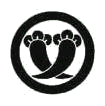 |
| Compounded Squares |
Orange Tree |
Oak Leaves |
Geese |
Clove |
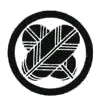 |
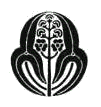 |
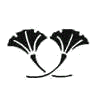 |
 |
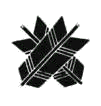 |
| Hoke feather |
Water grass |
Ginkgo leaves |
Leaves |
Arrow feather |
Now, let's look in the European version of Family Crest.
History of European Family Crest
The European family crest, particularly, the origin of Shield of Arms
has been identified in the early 12th century in England. In the 11th
and 12th century, common tactic of battle was grouped cavalry charge with
lance and shield into enemy once and if it did not break enemies away, then knights
went into combat with hand to hand. Because of massive hand combats,
often it was necessary to identify combatants with clear symbol mark. Some other
argument is that such emblem was used before William the Conquer in the northwestern Europe
and it was brought with the conquer into England.
Regardless these arguments, while the tournament started in France and became
popular in many areas among Europe, challenging knights were recognized with the coat
of arms, and ruling families were recognized with specific shield of arms and often
they were used as a seal of important document being sent to others
that was the origin of family crest.
In Europe particularly, in order to control the ownership of shield of arms,
the authority was established for marshaling and registration in
many countries. With each uniqueness in each country, however, there was
a certain control mechanism existed that was a major difference from Japanese family
crest. This point, in my opinion, is major cultural difference between
Japan and Europe.
The each family passed their family crest with male descendants in the case of
England, and the particular symbol mark was marshaled and
registered. For this purpose in England, the College of Arms was
developed and remains a vigorous institution.
Structure of European Family Crest
Since European family crest was controled by an authority in history, there was certain
rule established in the structure. It is the time that I have to mention on my
generalized term of [Family Crest] that is not correct in use, particularly, in
this section. The [Crest] needs to be used in the specific meaning for expressing the element
that sits on top of the Helm with the Wreath in many cases . Basic elements in the
arms are the Crest that sits at the top of arms, the Wreath typically exists under the
Crest, the Helmet sits just above the Shield, the Shield of cause the major element
of the heraldry, and other elements such as Mantle, Supporters and Motto in the Badge
are attached as the complete set of elements. Please look at following
element explanation.
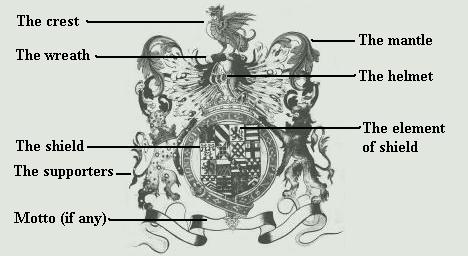
The Shield is the main portion of the heraldry, and the outlined shape of shield
itself does not have many variations, however, the design inside of shield
varies. In history, there was a written explanation of a design of arms existed, and
the officially written description of the shield of arms is called the
Blazon of Arms that is a system of code for describing dedicated colors, placement and
styling. As many years passed by, it is natural that the design of pattern in the
shield increased with many divided spaces and different elements that probably showing
the history of a family, relationship with others, strong wishes and so on. This
made a blazon of arms became more complicated.
Since the Crest sits at the top of arms, people often see that it is the main
body of the arms but it is not, and for instance, many french style of symbols do not have one.
The Supporters are often beasts, birds, monsters, human, or other shapes, and
they stand both side of shield of arms by supporting it.
I would like to show you examples of shield of arms in the 15th century that I borrowed from The Oxford Guide to Heraldry by
Thomas Woodcock and John Martin Robinson, Oxford University Press.



As a typical example, Windsor Herald is shown below that came from the same book mentioned
above. This is almost fully decorated in accordance with the Blazon of Arms.
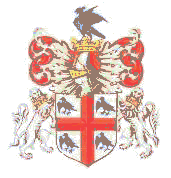
There was individual uniqueness in the heraldry in European countries. For instance in Germany,
multiple crests were observed in the arms, however, in France, virtually no crest existed.
Author of this article : Mas Nakano
Referenced book :
Kamon Jiten, Kenshiro Shindou, Nihon-Jitsugyou Shuppansha
The Oxford Guide to Heraldry, Thomas Woodcock and John Martin Robinson, Oxford University Press
Return to Index Page.
|